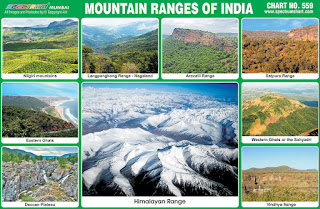 |
| Mountain Ranges of India Chart |
Spectrum Chart - 559 : Mountain Ranges of India
1. Nilgiri Mountains – Nilgiri, form
part of the Western Ghats in western Tamil Nadu, at the junction of
Karnataka and Kerala states in Southern India. At least 24 of the
Nilgiri mountains' peaks are above 2,000 metres (6,600 ft), the
highest peak being Doddabetta, at 2,637 metres. The Nilgiri Hills are
part of the Nilgiri Biosphere Reserve and form a part of the
protected bio reserves in India. Over 2,700 species of flowering
plants, 160 species of fern and fern allies, countless types of
flowerless plants, mosses, fungi, algae and land lichens are found in
the sholas of the Nilgiris.
2. Langpangkong Range (Nagaland) -
Langpangkong Range is a mountain range in Nagaland. It one of the six
major mountain ranges inhabited by the Ao people. It is located
between the valleys of the Dikhu and Milak rivers in the Mokokchung
District.
3. Aravalli Range - Aravali Range is a
range of mountains in western India running approximately 692 km in a
northeastern direction across the Indian states of Gujarat, Rajasthan
and Haryana, ending in Delhi. Aravalli range are the oldest Plateau
mountains in India. The highest peak is Guru Shikhar in Mount Abu in
Rajasthan.
4. Satpura Range - Satpura Range is a
range of hills in central India. The range rises in eastern Gujarat
state running east through the border of Maharashtra and Madhya
Pradesh to the east till Chhattisgarh. Most of the Satpura range was
heavily forested; but the area has been subject to gradual
deforestation in recent decades. Highest point of Satpura range is
Dhupgarh located in Pachmarhi, Madhya Pradesh. The eastern portion of
the range receives more rainfall than the western portion and the
eastern range, together with the Eastern Ghats, constitute the
eastern highlands moist deciduous forests eco region.
5. Eastern Ghats - Eastern Ghats or Purva
Ghat are a discontinuous range of mountains along India's eastern
coast. The Eastern Ghats run from the northern Odisha through Andhra
Pradesh to Tamil Nadu in the south passing some parts of Karnataka.
The mountain ranges run parallel to the Bay of Bengal. Eastern Ghats
are older than the Western Ghats, and have a complex geologic history
related to the assembly and breakup of the ancient supercontinent of
Rodinia and the assembly of the Gondwana supercontinent.
6. Western Ghats (Sahyadri) - Western
Ghats is a mountain range that runs parallel to the western coast of
the Indian peninsula, located entirely in India. It is a UNESCO World
Heritage Site and is one of the eight "hottest hot-spots"
of biological diversity in the world. Western Ghats are the
mountainous faulted and eroded edge of the Deccan Plateau. Western
Ghats extend from the Satpura Range in the north, stretching from
Gujarat to Tamil Nadu.
7. Deccan Plateau - Deccan Plateau is a
large plateau in India, making up most of the southern part of the
country. It rises to 100 metres in the north and to more than 1 km in
the south, forming a raised triangle within the downward-pointing
triangle of the Indian subcontinent's coastline. The climate of the
region varies from semi-arid in the north to tropical in most of the
region with distinct wet and dry seasons. Rain falls during the
monsoon season from about June to October.
8. Himalayan
Range - Himalaya are a mountain range in Asia separating the
plains of the Indian subcontinent from the Tibetan Plateau. Himalayan
range is home to the planet's highest peaks, including the highest,
Mount Everest. Himalayas are spread across five countries Bhutan,
India, Nepal, People's Republic of China and Pakistan with the first
three countries having sovereignty over most of the range. The flora
and fauna of the Himalayas vary with climate, rainfall, altitude, and
soils. The climate ranges from tropical at the base of the mountains
to permanent ice and snow at the highest elevations.
9. Vindhya
Range - Vindhya Range is a complex, discontinuous chain of
mountain ridges, hill ranges, highlands and plateau escarpments in
west-central India. The range extends up to Gujarat in the west and
Uttar Pradesh and Bihar in the east.

No comments:
Post a Comment